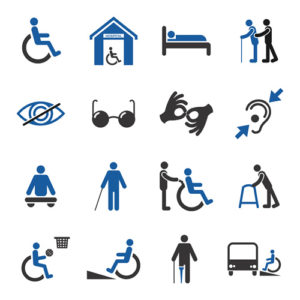Those who are in higher education are probably tired of hearing about accessibility. But accessibility awareness is the key point to making courses accessible. Bringing this awareness to faculty on how they design a course had been an ongoing charge for those in higher education that work with course design.
Dispelling myths about accessibility in an online environment
Myth #1: Students with learning differences don’t take online courses.
Many students do not report the need for accommodations in an online course. Why? They have to jump through so many hoops to get an accommodation. First, there’s the letter from Disability Services (how about naming it Accessibility Services?) every semester; then they have to explain the accommodation to the instructor and discuss why the accommodation is needed every semester. And then there is the social stigma attached to reporting an accommodation. This procedure is stressful for students and often hinders student success. But taking an online course is beneficial for students who struggle with social anxiety, who need flexibility, or who need to learn in chunks in a safe environment.
Instead, how about making a course accessible from the beginning? Isn’t online learning supposed to be inclusive?
Related: How to make sure your university’s online content is accessible to all
Myth #2: Captioning is just for those who are hearing impaired.
Recently, I put in a large grant request to provide professional captioning services for faculty who use videos that are required for online learning and assessment. I presented to a committee, showing them a 30-second YouTube video that was filmed on our campus and welcomed students. I turned the volume off, handed the committee an auto-generated transcript from YouTube, and asked them to read the transcript while watching the video. This is how we ask students who need captioning to learn while watching videos. Try it! It is very challenging!
After about 10 seconds, they put the transcript down and my request was granted.
Captioning is not just for those who need accommodations because of hearing differences. It is for the international students who experience language barriers, students who learn differently, and for those who might need to watch a video in a sound-sensitive area (e.g., a library, someone taking care of a sick kid who is sleeping). Doing what we ask our students to do in the world of accessibility brings awareness.
Myth #3: Screen readers are just for those who are visually impaired.
Students are busy and often revert to listening to content while multitasking. This includes digital textbooks or anything that is on a screen for a course and can include hyperlinks. I have Apple CarPlay in my car and it connects to my phone. I received a message from of my sons with a hyperlink in it and the message read the hyperlink as it was: http://www.blahblahblah.com/3892018dzadyd. My passenger said, “What the heck?” Siri was reading me the hyperlink. This is a perfect example of how hyperlinks in digital content works.
I recently consulted with a group of new faculty and demonstrated how a screen reader works. One of the attendees thanked me for bringing awareness to the group. Her mom was an online student who did not report a visual difference and she watched as her mom struggled for four years with screen readers and hyperlinks. Again, awareness is a huge part of getting in the know.
Myth #4: Cognitive overload is not really a thing.
In an online course, it is very easy to copy/paste content and sometimes we get carried away. Cognitive overload is where faculty provide too much information or too many tasks that need to be done all at once. Do students really need to answer the same question with multiple means of stimulation or will a quick quiz before (formative assessment) and after reviewing content (summative assessment) work? Do all students need to take all their finals on the same day?
Related: Roll up your sleeves! Why accessibility in higher ed needs all hands on-deck
For students who need accessibility accommodations or experience learning differences, cognitive overload is a big hurdle. Surveying students at the beginning of a course will let faculty know what is too much or too little for any given course. Even if your content stays the same, your students change every semester.
As faculty work on continuous improvement in teaching, every semester is a good time to reassess how accessible your course is for students. Making content that is inclusive leads to happier and more successful students which, in turn, reflects on faculty who really care.
- AI and the workforce: Reskill to meet the moment - July 1, 2025
- Beyond the game: Why business expertise is the future of sports management - June 26, 2025
- How unified payment strategies drive student success - June 23, 2025
